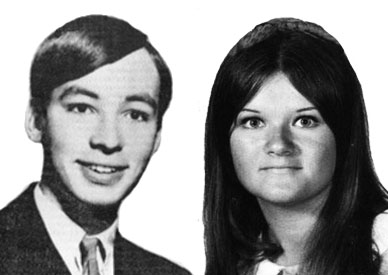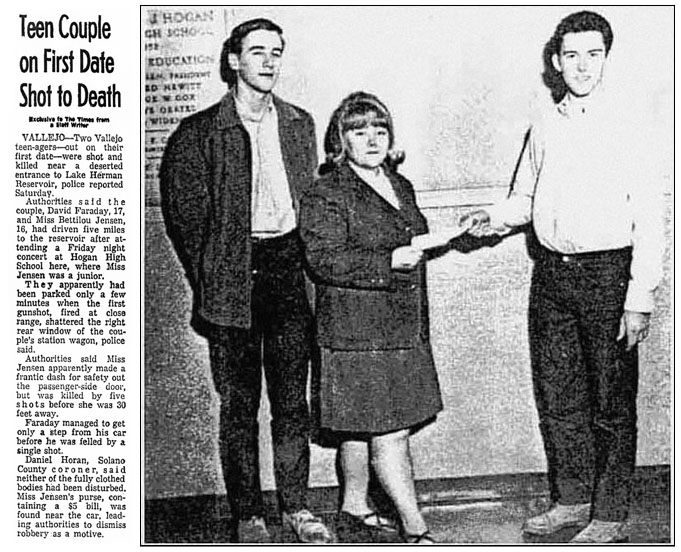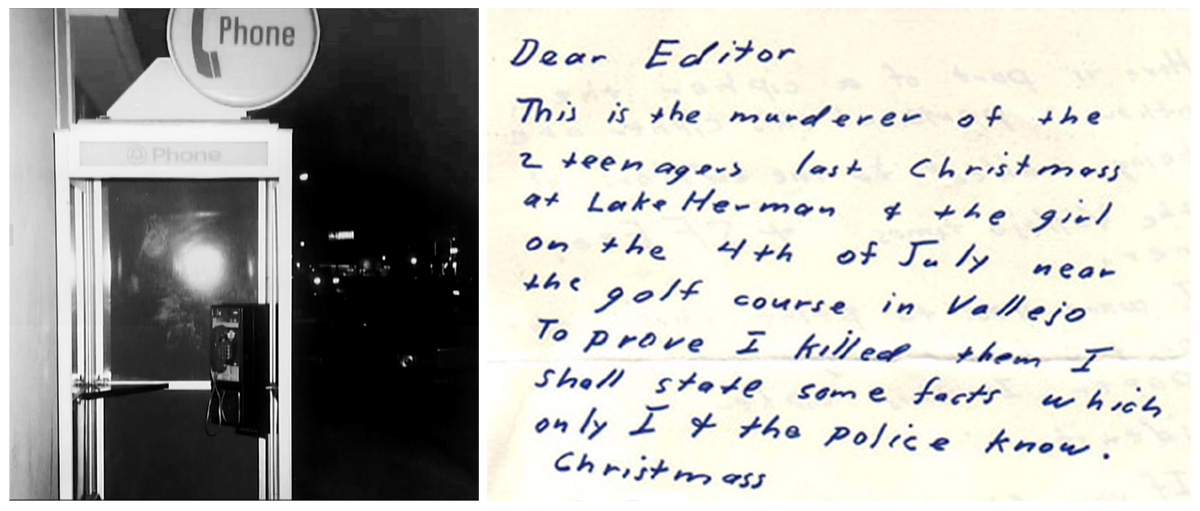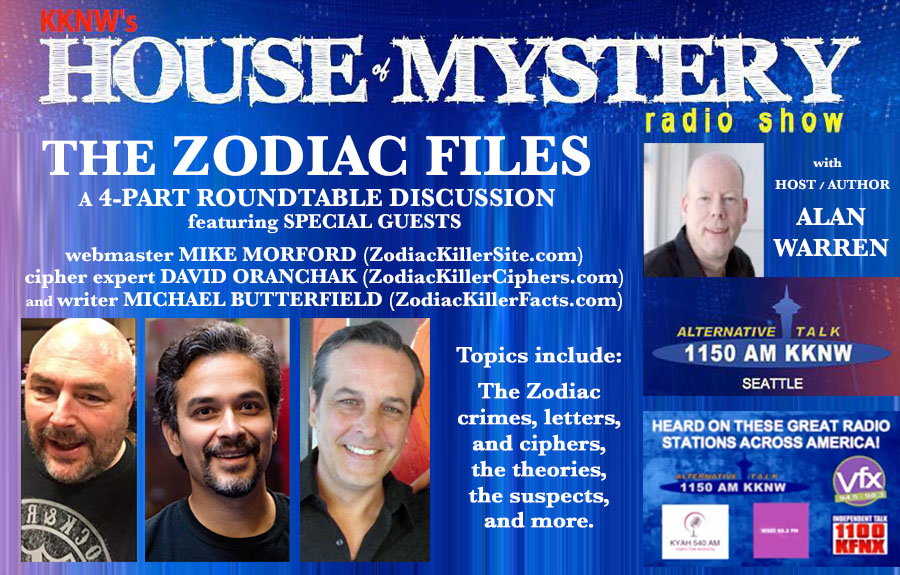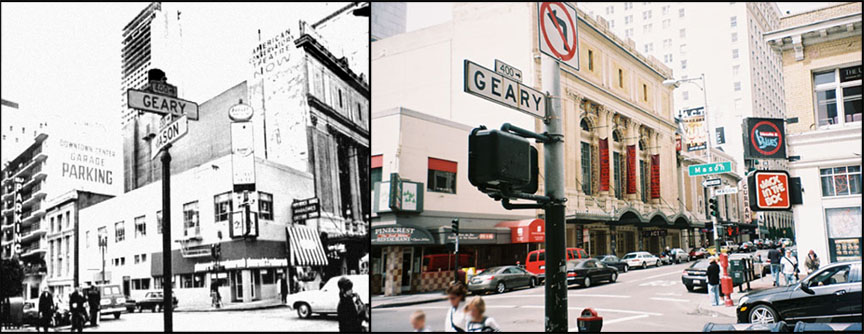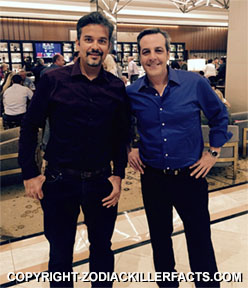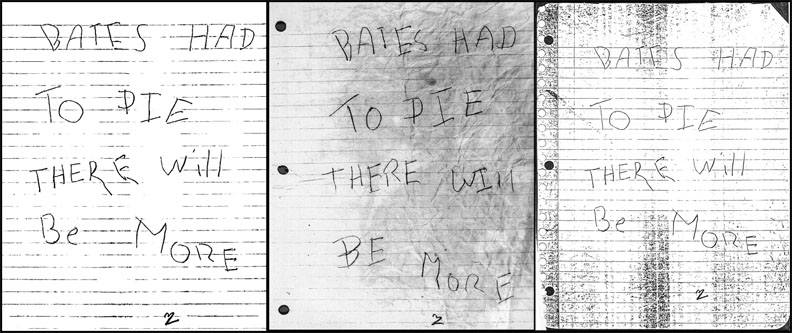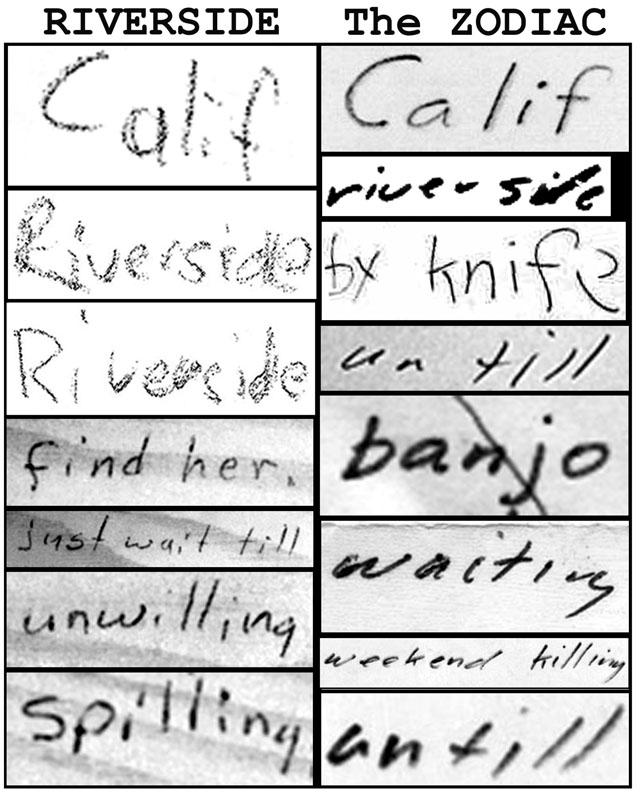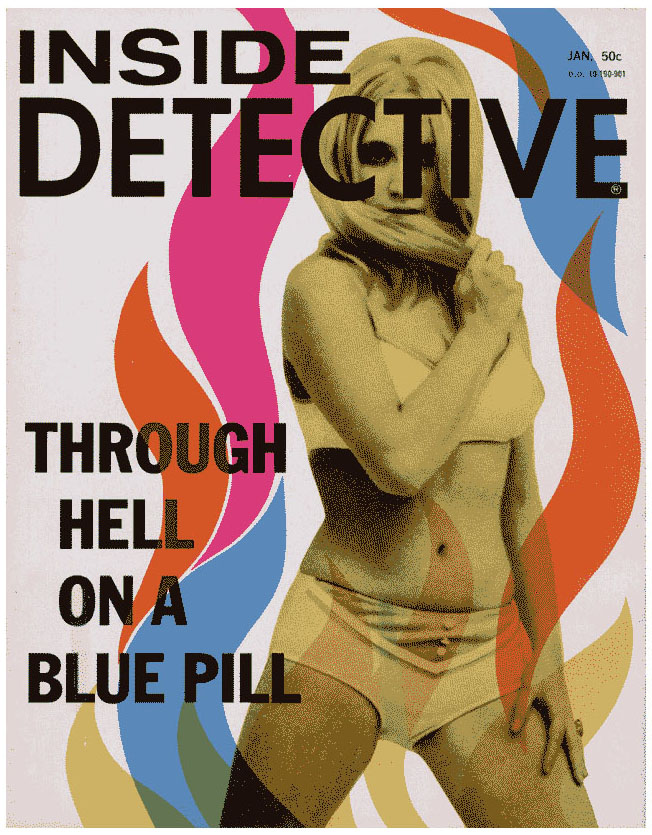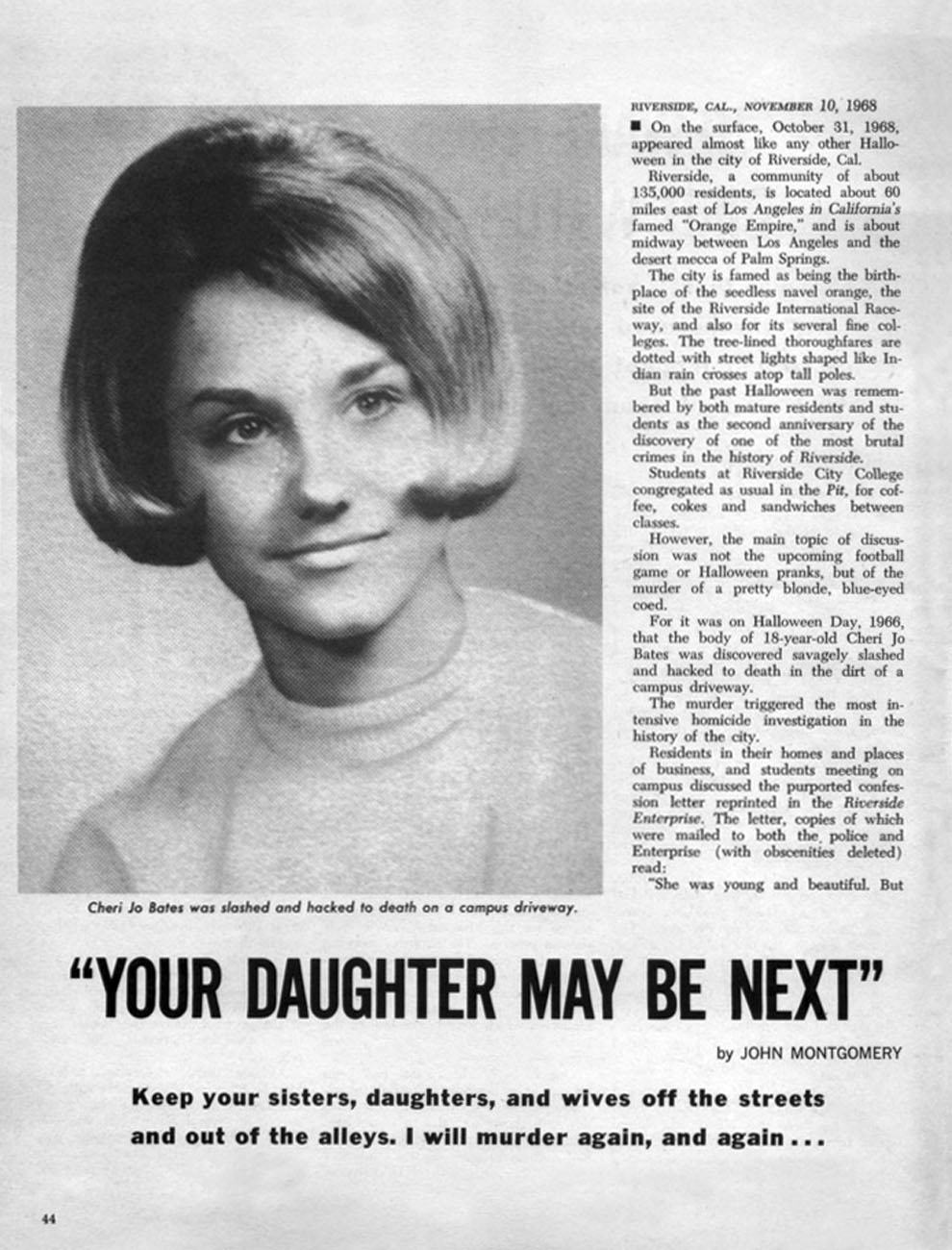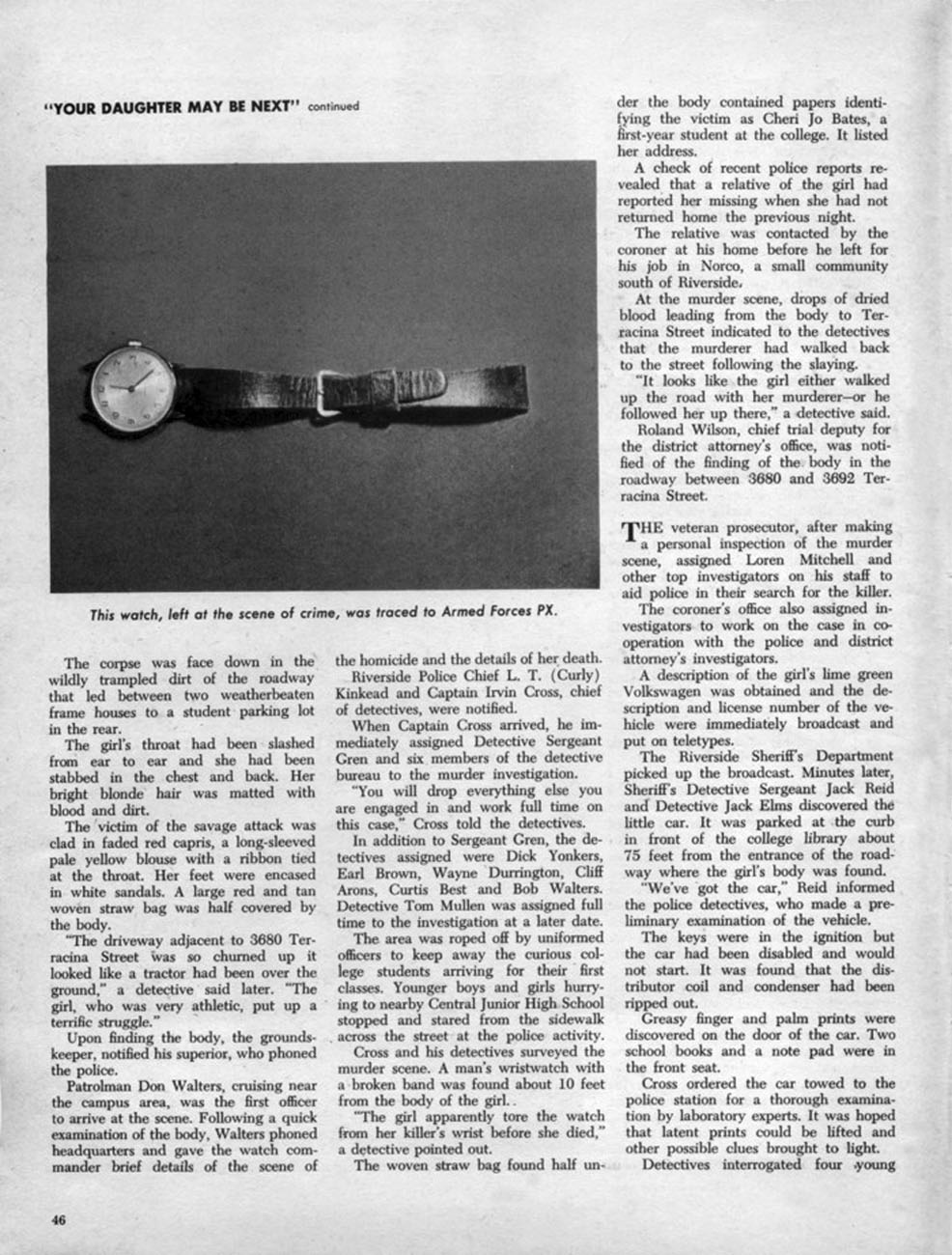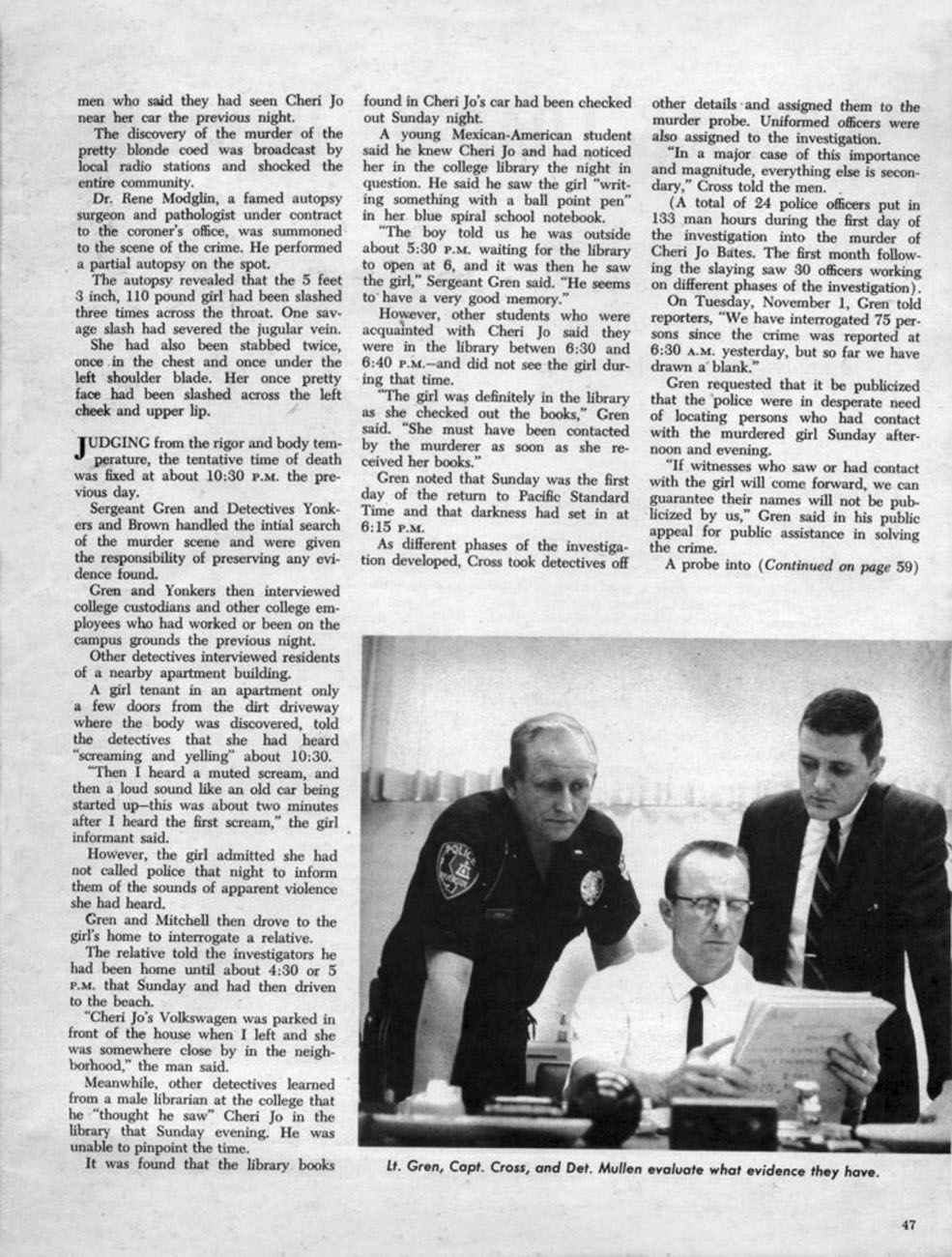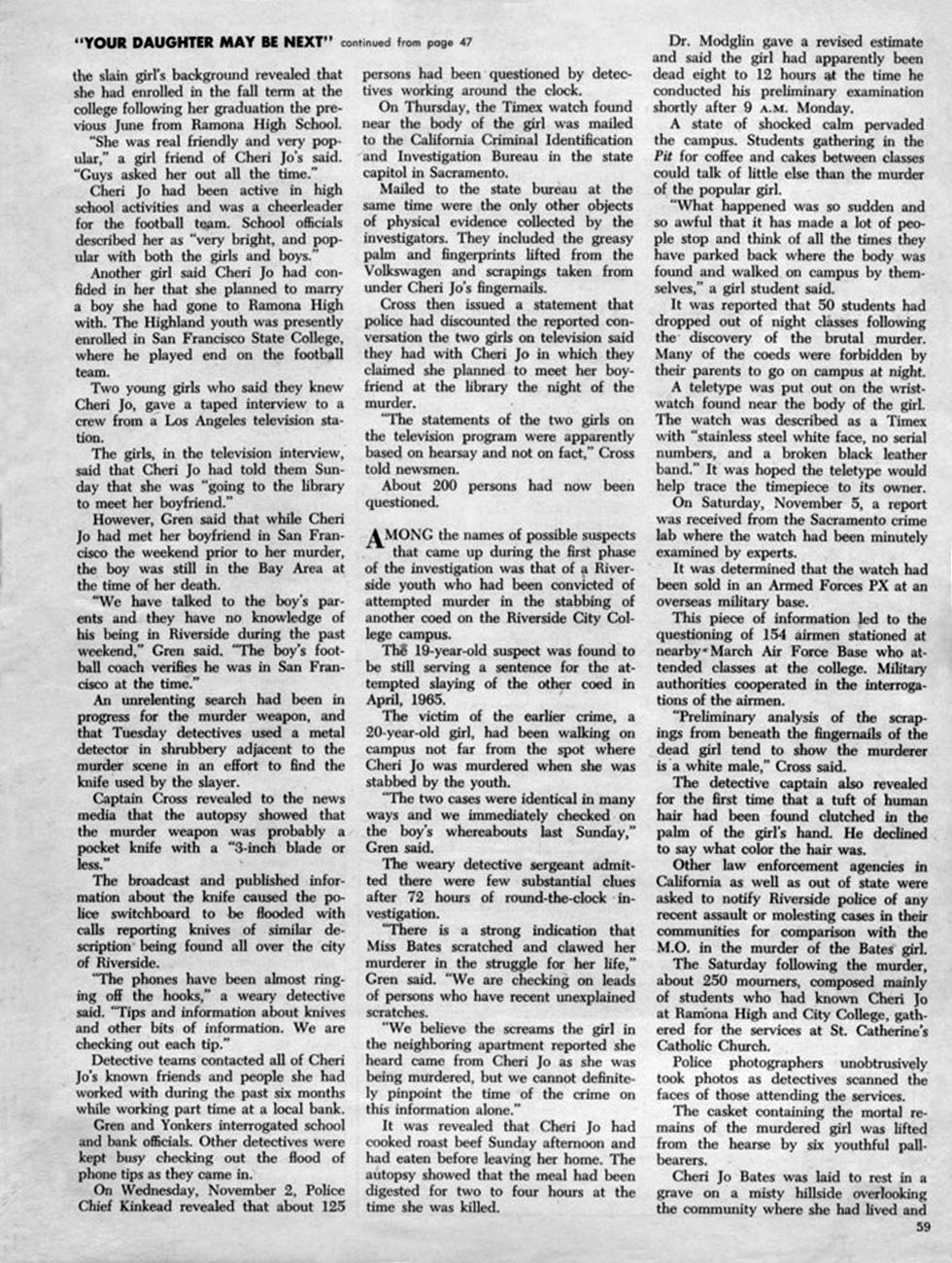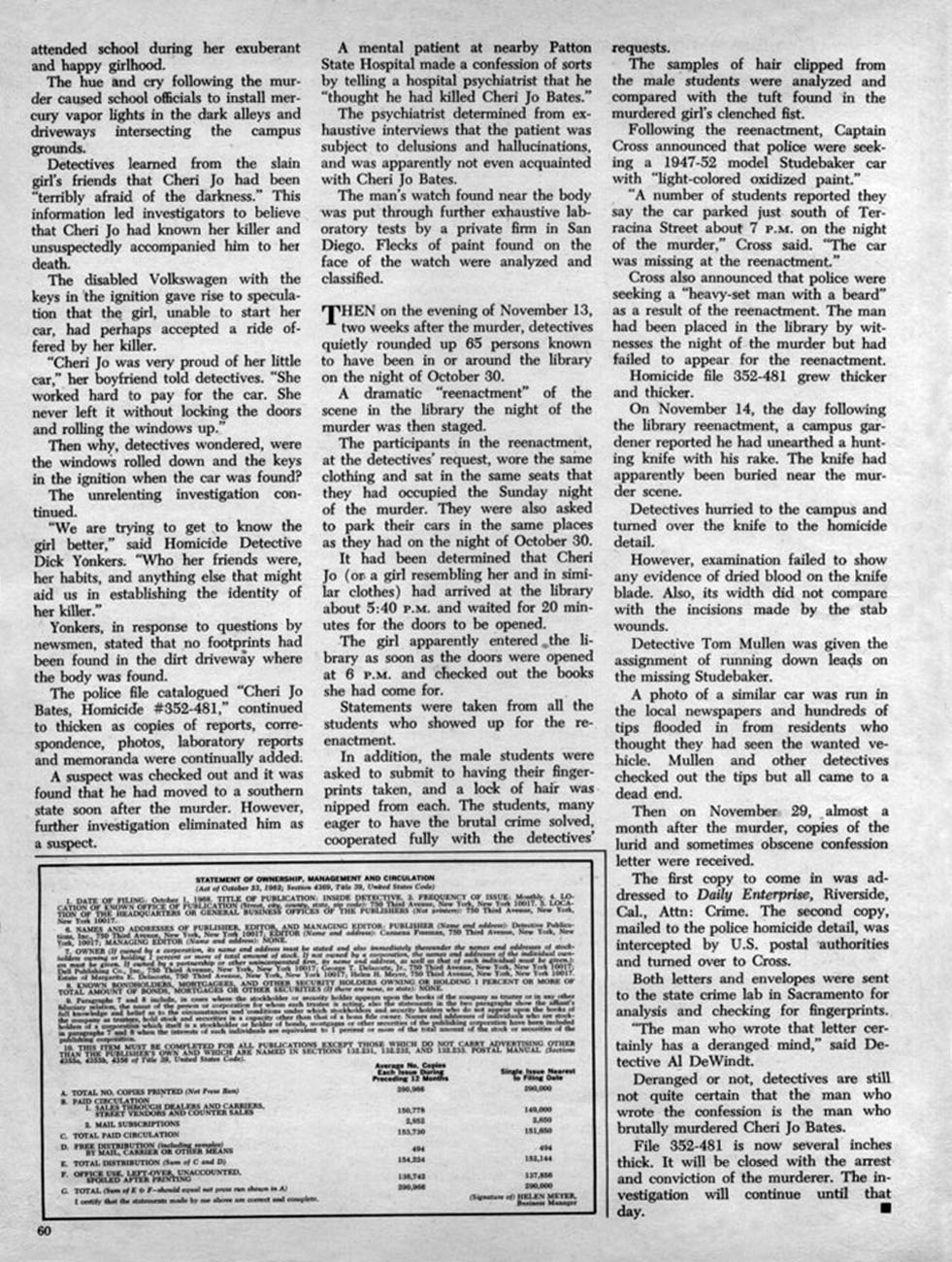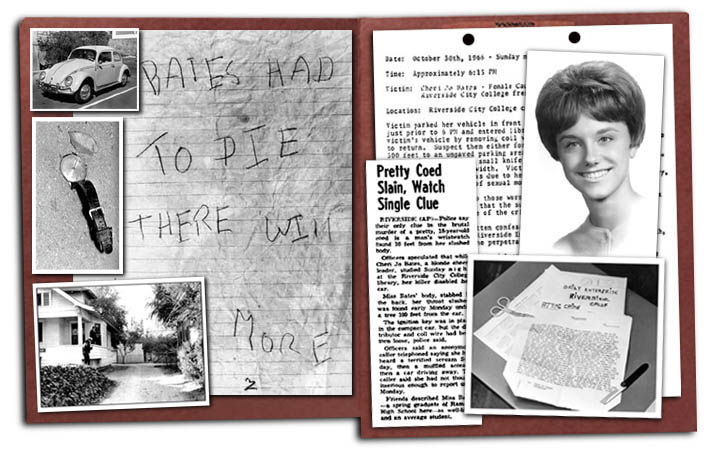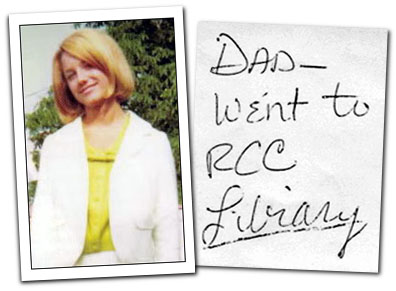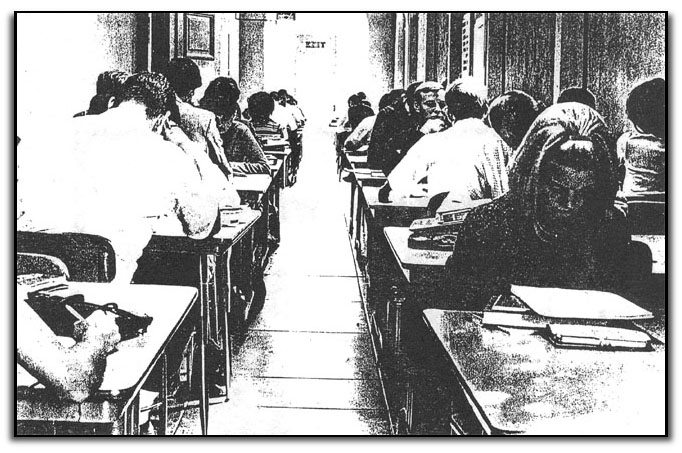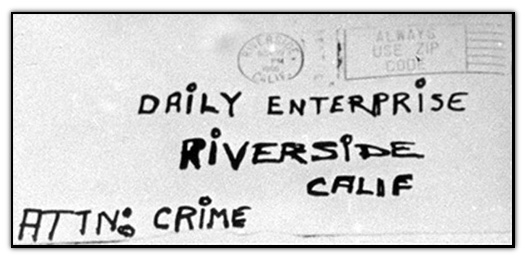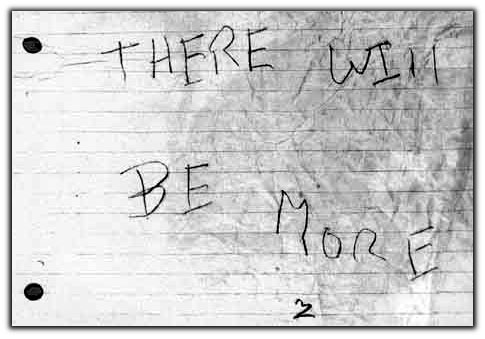Like many infamous unsolved cases, the Zodiac mystery draws its share of those who claim to have the solution. In more recent years, a new phenomenon has dominated media reports, the “daddy did it” claims from children who seek publicity. Several people have “identified” their fathers or stepfathers as the Zodiac killer, and this trend has fueled repeated media cycles with a publicity tour for the accuser. Gary Stewart stepped into the spotlight when he identified his father as the Zodiac killer. Stewart’s claims may have seemed compelling to some observers but his story was all too familiar.
Deborah Perez made headlines when she claimed that her father Guy Ward Hendrickson was the Zodiac. She also claimed that she accompanied him during some of the crimes and had even written some of the Zodiac’s letters. Law enforcement agencies did not agree with Perez’s conclusions and other people came forward to report that she had also claimed to be the daughter of President John F. Kennedy.
Dennis Kaufman claimed that his stepfather Jack Tarrance was the Zodiac. Kaufman offered many theories linking Tarrance to other infamous crimes and even produced a hooded costume and rolls of film which allegedly linked the suspect to the Zodiac murders and other killings. Law enforcement agencies were not impressed and ultimately ignored Kaufman’s ongoing media circus.
Retired detective turned writer Steve Hodel found fame when he claimed that his father was responsible for the infamous “Black Dahlia” murder in 1947. The best-selling book Black Dahlia Avenger offered evidence said to link George Hodel to the crime, including photographs found among George Hodel’s possessions which Steve Hodel claimed depicted “Dahlia” victim Elizabeth Short. Skeptics disagreed and members of Short’s family eventually stated that the woman in Hodel’s photographs was not Elizabeth. Hodel then published another book titled Most Evil which claimed that George Hodel was also the Zodiac killer. This book featured many claims which proved false and most of Hodel’s theory was easily debunked.
Perez, Kaufman, Hodel and others all claimed that handwriting experts-for-hire determined that their suspects had written the Zodiac letters. Each claimed that compelling evidence proved that they had identified the Zodiac but none offered such evidence. All of these individuals spoke with certainty that they had solved the mystery when the facts proved otherwise. Yet, all of these people were celebrated by media with little interest in the facts and an ongoing need for sensational content. The authors and their publicists know that most people do not know enough about the Zodiac case to adequately scrutinize these sensational claims.
Part I: A REASON TO BELIEVE
Many books have been written about the Zodiac mystery but few received the publicity surrounding the release of Gary Stewart’s book titled The Most Dangerous Animal Of All. With co-author Susan Mustafa, Stewart described the search for his biological father, Earl Van Best, and his eventual conclusion that the same man was also the Zodiac killer. Stewart was interviewed on numerous television and radio programs and his solution was praised by many readers who posted positive reviews on Amazon.com.
I listened to one radio broadcast as a woman described how she had read Stewart’s book and was utterly convinced that he had solved the case. The host agreed with the caller and hoped that the San Francisco Police Department would conduct tests to determine if Best’s DNA matched a partial DNA profile obtained from the envelopes mailed by the Zodiac. Stewart repeatedly said that he wanted a DNA comparison and believed that the results would prove he had identified the killer. Other listeners did not realize that there were two major problems with Stewart’s version of the story.
1) The partial DNA profile obtained by the San Francisco Police Department is only a partial profile, meaning, it can only be used to exclude a suspect as the source of the DNA. The information is not sufficient to provide a conclusive match to any one person. And, some people believe that others who handled the envelopes were potentials sources of the DNA.
2) DNA tests should be conducted on viable suspects who have been implicated by other credible evidence. The SFPD cannot afford to test the DNA belonging to every suspect identified by attention seekers and opportunists. Doing so would only encourage others to come forward with false claims which waste law enforcement resources.
Gary Stewart would require hard evidence if DNA tests could not positively identify the Zodiac killer. Such evidence would be necessary prior to accusing a suspect, but Stewart’s book offered no reason to accept his solution to the case.
Part II: NO SIGN OF THE ZODIAC
Page 322 of the book The Most Dangerous Animal Of All described Gary Stewart’s meeting with his co-author Susan Mustafa. Stewart asked if Mustafa was interested in writing his Zodiac book and the author reportedly replied, “I’m not willing to put my reputation on the line unless I believe what I’m writing.” The resulting book was then marketed as the solution to the Zodiac mystery. Unsuspecting readers might be impressed by the book and its claims but the facts told a different story.
In the book’s introduction, Stewart wrote that he conducted twelve years of research and intended to leave “no doubt as to the identity” of the Zodiac. Part one of the book included approximately one hundred and thirty pages devoted to the life of Earl Van Best. At the age of twenty-eight, Best married fourteen year-old Judy Chandler. Best was eventually arrested on statutory rape charges and was sent to prison. Articles about Best and Chandler appeared in The San Francisco Chronicle newspaper called the story “the Ice Cream Romance” because Best and Chandler met in an ice cream parlor. Chandler gave birth to Gary Stewart and joined Best after his release from prison. However, she later took then four year-old Gary and left Best to escape the abusive relationship. Decades later, Stewart watched a television show about the unsolved mystery and realized that Best somewhat resembled the police sketch of the Zodiac suspect.
Stewart and Mustafa suggested a link between Best and Chronicle writer Paul Avery. According to the book, Avery authored a series of articles about the so-called “Ice Cream Romance” and Best was somehow offended. Best, as the Zodiac, then sent a threatening Halloween card to Avery. However, Stewart and Mustafa presented no evidence that Avery was the author and other information indicated that Avery did not write the “Ice Cream” articles.
The authors claimed that Van Best’s name appeared in the Zodiac’s ciphers. The book presented a photograph of the Zodiac’s first cipher and the symbols surrounding the word “best” in the deciphered text. The symbols V and E are substituted for the letters B and E in the deciphered text. In Stewart’s illustration, the two lines of symbols above the word “best” are highlighted to emphasis the letters J and R. According to Stewart, this configuration implied the name of his father, Earl Van Best, Jr. This strained interpretation was hardly conclusive and relied on the assumption that the Zodiac intended for his name to be noticed in both the original symbols and deciphered text together at the same time. The initials were not in the proper order and the lines containing the letters J and R were not the same as the line which contained the letters V and E.
Stewart and Mustafa further claimed that another Zodiac cipher implicated Best. The still-unsolved cipher contained thirteen symbols. The name Earl Van Best, Jr. contained thirteen letters. Stewart viewed this as more than coincidence and posted this “evidence” on his website. However, he did not provide any reason to believe that the thirteen symbols actually represented the letters in the Van Best name. Like other Zodiac theorists, Stewart simply assumed a connection which favored his pre-selected conclusion. Other theorists noted that the Zodiac’s first cipher contained eighteen symbols of apparent gibberish which could somehow contain the killer’s identity. Infamous “Unabomber” Ted Kaczynski was identified as a potential Zodiac suspect at one time, and the name Theodore J. Kaczynski contains eighteen letters. The same method could be used to find a “match” to many other names.
According to the book, Susan Mustafa’s literary agent found Best’s name in the Zodiac’s so-called “340 cipher.” He located a backward letter B and then began looking for the other letters, eventually discovering the entire name “Earl Van Best Junior.” The agent used a series of unidentified symbols to form the word “Junior.” Stewart and Mustafa assured readers that the agent tried to repeat the same results with other names but failed. This cipher solution may have seemed compelling but the methods used to achieve the results were designed to favor the desired outcome. Mustafa’s literary agent simply assigned his own predetermined letters of the alphabet to his chosen symbols in the Zodiac’s “340” cipher. This solution also assumed that the triangle symbol in the cipher represented the letter A, that a half-filled circle represented the letter E, that an “I” symbol represented the letter L, and that the “V” symbol in the cipher represented the letter U. Without these assumptions, the literary agent could not construct Best’s name. The agent wanted to find Best’s name and then made his own assumptions in order find Best’s name. No one else would have any reason to look for Best’s name in the cipher and no one would make the same assumptions while attempting to solve the cipher. According to the logic used by Stewart and the literary agent, the Zodiac’s cipher could only be solved by someone who already knew the identify of the Zodiac killer.
Stewart, Mustafa and the literary agent offered no legitimate reason to believe that their methods were sound other than the fact that those methods achieved the desired results.
Part III: THE END OF THE ZODIAC MYSTERY
Gary Stewart’s book offered the only “direct evidence” said to link Earl Van Best, Jr. to the Zodiac crimes. On page 329, Stewart and co-author Susan Mustafa stated that Lieutenant Bob Garrett examined the fingerprints found at the scene of the Zodiac’s last known crime, the killing of cab driver Paul Stine in San Francisco. Garrett stated that he could not make a positive match between the possible Zodiac fingerprints and the fingerprints of Earl Van Best. Instead, Garrett provided a visual comparison for Stewart and Mustafa which showed a possible Zodiac fingerprint and Best’s fingerprint. According to Stewart and Mustafa, both fingerprints showed what appeared to be a scar. However, Garrett was forced to reverse the Zodiac fingerprint in order to align the possible scar on the correct side in order to match the same possible scar on the Best fingerprint. Stewart and Mustafa believed that the aligned scars on both fingerprints served as compelling evidence that Best killed Paul Stine.
A report written by SFPD Inspector William Hamlet described the fingerprints found at the crime scene:
“All of the latent prints in our case were obtained from a taxi cab. The latent prints that show traces of blood are believed to be prints of the suspect. The latent prints from right front door handle are also believed to be prints of the suspect. These prints are circled with a red pen. The other latent prints many of which are very good prints, may or may not be the prints of the suspect in this case”
The fingerprint isolated and compared by Stewart, Mustafa and Garrett was not among those latent fingerprints which were circled in red as stated in the SFPD report. The fingerprint was found at the crime scene but no one knew if that fingerprint actually belonged to the killer. Further, the only way to link Earl Van Best to the crime relied on assuming that the print was left by the killer and then reversing the image of that print. As a further stretch, the assumption that the print was valid and the reversal of the image did not produce any match between the fingerprint found at the crime scene and Best’s fingerprint. The reversal only changed the placement and alignment of a line which may or not be a scar. The faint line which appears to run through the fingerprint in question could have been produced by some feature or indentation on the surface of the cab where the print was obtained.
The methods used to achieve the favorable results were unreliable and self-serving. Stewart and Mustafa had no reason to believe that experienced police officers had somehow reversed the fingerprint. The authors simply assumed that such a reversal had occurred and then reversed the image to suit their needs. The fingerprint evidence did not link Earl Van Best to the murder of Paul Stine.
Stewart and Mustafa also consulted document examiner Mike Wakshull. Wakshull initially thought the evidence was not sufficient to reach a conclusion, however, he quickly changed his mind and concluded that Earl Van Best, Jr. had written the Zodiac letters. Wakshull stated, “I am virtually certain that the writer of the marriage certificate between Earl Van Best Jr. and Judith Chandler is the same writer as the writer of the Zodiac letters.” Wakshull was not hesitant in his conclusion; he even published his own book with a title that left no room for doubt– The End of the Zodiac Mystery.
In his book, Wakshull described his methods and the handwriting samples used in his examination. Wakshull wrote, “The only writing from Van on the first and the third marriage certificates was his signature. Regarding the second marriage certificate, Judith had attested to Gary that Van completed all the information except the witnesses’ signatures, including her printed name.” Wakshull then explained that he “had only four documents for comparison, three of them containing only Van’s signatures.” The fourth document was the marriage certificate reportedly completed by Best himself. This marriage certificate was included in the photograph section of Stewart’s book but the image was very small. At least four different photograph exhibits of handwriting comparisons between the Zodiac’s writing and Best’s writing cited this marriage certificate as evidence.
According to Wakshull, Judy Chandler claimed that Earl Van Best completed and signed the marriage certificate. Shortly after the publicatios of Stewart’s book, Zodiac theorist Mike Rodelli reported that he had contacted the church where Stewart’s parents had married. According to a church source, the writing on the marriage certificate was that of Reverend Edward Fliger, the man who had presided over the marriage ceremony of Earl Van Best and Judy Chandler. Other samples of Filger’s writing on other marriage certificates were remarkably similar to the writing on Best’s marriage certificate. Wakshull claimed that the writing on the marriage certificate was that of the Zodiac killer. According to Wakshull’s conclusion, Filger had written the Zodiac letters.
Wakshull’s conclusion that Best had written the Zodiac letters relied heavily on the assumption that Best was responsible for the writing on the marriage certificate, and any conclusion based on that mistaken assumption could not be valid. The removal of the Best/Chandler marriage certificate from the known writing samples of Earl Van Best, Jr. left Wakshull with only three signatures to compare to the Zodiac’s writing. Therefore, certain letters of the alphabet were not available in the Best signatures to compare with the same letters which appeared in the Zodiac writings. Three signatures were not sufficient to form a valid conclusion.
The evidence presented in his book did not support Stewart’s claims that his father was the Zodiac killer.
Part IV: THE DEVIL YOU KNOW
According to Gary Stewart, Earl Van Best, Jr. killed several human beings and then escaped justice. Stewart wanted the San Francisco Police Department to conduct DNA tests to determine if Best’s DNA matched a partial DNA profile obtained from envelopes which contained Zodiac communications. The SFPD would not oblige Stewart and instead ignored his claims. Stewart had to explain why authorities did not accept his solution to the mystery and he offered an answer. Co-author Susan Mustafa hinted at this explanation in an interview published in The Advocate. “The book involves a bit of the SFPD not wanting to cooperate for a reason that’s the hook of the book,” Mustafa said. “You’ve got to read the book for that.”
Stewart’s mother Judy divorced Earl Van Best Jr. and later married a man named Rotea Gilford, a man often described as the first African-American investigator to work in the San Francisco Police Department. In Stewart’s scenario, the Best-Gilford connection embarrassed the SFPD, perhaps enough to conceal the fact that Van Best was one of the most notorious serial killers in American history. In support of this conspiracy theory, Stewart claimed that the SFPD possessed a secret file containing the horrifying truth about the life and crimes of Earl Van Best Jr.
According to Stewart, his mother Judy wanted to see the San Francisco Police Department file on Best, but a police representative refused, saying, “I am not going to reveal what is in that file. It would make what he did to you look inconsequential.” Judy then turned to her husband’s former partner, Earl Sanders. On page 242 of his book, Stewart stated that Judy met with Sanders and then called her son to report, “He says he can’t tell us what your father did. He says what your father did was so heinous that it would destroy us.” Stewart did not learn the contents of the SFPD file on Best but his public comments indicated that he believed the secret file contained some link between his father and the Zodiac crimes.
In his book, Stewart stressed an alleged connection between Best and the infamous satanist Anton Lavey. In 1966, Lavey founded The Church of Satan in celebration of what he declared to be Anno Satanas, the first year of the Age of Satan. Lavey’s sensational publicity stunts earned him a reputation as an American bogeyman, but Stewart offered no evidence that Lavey or Van Best were responsible for any murders. In a television interview, San Francisco Chronicle reporter Paul Avery mentioned that members of The Church of Satan had once suspected another member may have been the Zodiac. Avery joked that “the Zodiac was so bad, even The Church of Satan didn’t want him.” Avery’s comments notwithstanding, no one had presented any evidence which linked the Zodiac to The Church of Satan or any occult activity of any kind.
Stewart also claimed that Earl Van Best Jr. was connected to Bobby Beausoleil, a biker linked to the “family” of killers led by Charles Manson. Beausoleil was convicted for his role in the murder of music teacher Gary Hinman. Beausoleil was also known for his appearance in the film Lucifer Rising along side author and director Kenneth Anger and singer Marianne Faithfull. Steve “Clem” Grogan, another member of the Manson “family” performed in a band with Beausoleil and was also convicted for killing Hinman. In his book, Stewart wrote that he received an email in which Beausoleil stated that he had “jammed” with Best and other musicians. Stewart did not present any evidence to indicate these relationships connected Best to the Zodiac crimes. Instead, the emphasis on these relationships relied on the old ploy of guilt by association.
Stewart was apparently unable to link Best to any crime other than the original statutory rape charges regarding Stewart’s mother Judy. The “heinous” truth allegedly concealed in Best’s police file has not been revealed, but Stewart believed that the SFPD’s refusal to reveal its contents could be evidence of an ongoing cover-up. Stewart also implied that this cover-up was linked to the SFPD announcement that the case had been “closed” in 2004. In fact, the case status was only “inactive,” meaning that the department would not devote substantial resources to the cold case without a new lead or new evidence.
Stewart was not the first to claim “cover-up.” Steve Hodel claimed that his father George Hodel was California’s Zodiac killer, the “Black Dahlia” killer of Los Angeles, and Chicago’s notorious “Lipstick killer.” According to Hodel’s version of the story, the arrest of his father would expose corruption and destroy the careers of important officials who allowed him to escape justice. Dennis Kaufman claimed that authorities knew that his step-father Jack Tarrance was the Zodiac but conspired to conceal this fact for unknown reasons. Blaine Blaine aka “Goldcatcher” claimed that Napa County Sheriff’s Department investigator Ken Narlow, Department of Justice Agent Fred Shirasago and others were conspiring to discredit Blaine and help his suspect escape justice. Howard Davis claimed that officials inside the Los Angeles District Attorney’s Office conspired to conceal the connection between the Zodiac crimes and Bruce Davis, a member of the infamous “family” of killers led by Charles Manson. Hodel, Blaine, Kaufman and Davis did not provide any credible evidence to support their continuing claims of conspiracies and official cover-ups.
Gary Stewart offered no credible evidence to indicate that his father was responsible for the Zodiac crimes. Instead, he insisted that the San Francisco Police Department conduct DNA tests to prove whether or not Earl Van Best, Jr. was the Zodiac. The implied conspiracy to conceal the heinous truth about Best’s secrets was a convenient excuse to explain the lack of evidence to support Stewart’s claims.
Part V: STEWART’S TRUTH DEBUNKED
Despite his earlier contact with Lieutenant John Hennessy, the San Francisco Police Department has expressed no interest in any further examination of the claims made by Gary Stewart. Despite the publicity surrounding the release of his book, Gary Stewart failed to convince anyone but uninformed readers. WIthin days of its release, much of the “evidence” presented in Stewart’s book was debunked and dismissed. Even Stewart’s mother Judy was not convinced. According to Stewart, Judy “cannot imagine that Van could be capable of such violence.” Judy reportedly referred to Stewart’s Zodiac claims as “fiction.”
During his many media interviews, Gary Stewart consistently stated his certainly that Earl Van Best, Jr. was the Zodiac. Stewart referred to his claims as “the truth about my life.” In a CNN interview with Erin Burnett, Stewart boasted, “I believe for the first time in the history of this case that I have presented more evidence than has ever been presented on any one suspect.” Stewart’s certainty was not justified by the evidence.
A handwriting expert examined alleged samples of Best’s writing and determined that Best had written the Zodiac letters. One of these handwriting samples was apparently written by someone other than Best, casting serious doubts on the conclusions of the expert. The cipher solutions by Stewart and his literary agent relied on unreliable methods which could be used by others to reach their own preconceived results. Beyond the story of the relationship between his mother and father, Stewart offered no evidence that Earl Van Best was responsible for any crimes. Alleged connections between Best, satanist Anton Lavey and Manson associate Bobby Boeuseliel could not link Best to the Zodiac murders.
The only remaining “evidence” said to link Best to the Zodiac crimes seemed to be little more than trivia:
* Best somewhat resembled the composite sketch of the Zodiac.
* Best was reportedly in California during the time of the Zodiac crimes.
* Best liked Gilbert and Sullivan operas.
* Best had some interest in ciphers when he was younger.
* Best allegedly knew a satanist and allegedly played music with a murderer.
* Best was an immoral person who may have committed crimes.
This list was not conclusive or compelling. Similar lists could be said to implicate other suspects. Stewart’s self-serving cipher solutions, creative fingerprint claims, and invalid handwriting analysis were easily debunked, leaving only the trivia to justify the ongoing accusation that Earl Van Best, Jr. was the Zodiac killer. Contrary to his boasts during the CNN interview, Gary Stewart did not present any credible evidence to indicate that his father was the Zodiac.
Stewart’s co-author Susan Mustafa staked her reputation on the book and its claims. “I’m a true-crime writer. I have a reputation for research and accuracy,” Mustafa said. “If I didn’t believe this, I would never put my reputation on the line for it.” According to the story told in the book The Most Dangerous Animal Of All, Stewart and Mustafa never possessed any credible evidence to link Best to the Zodiac crimes.
An article in People magazine featured a photograph of a confident Gary Stewart along with the quote, “I know people are going to try and shoot this down.” Stewart’s baseless claims made an easy target for critics and his “evidence” collapsed under minimal scrutiny. Unfortunately, most media reports and book reviews did not scrutinize Stewart’s claims. The campaign launched by the publisher, Harper Collins, ensured that Gary Stewart and his claims would saturate the media just as the book was released to the public. However, Harper Collins managed to keep the release secret until The Most Dangerous Animal Of All hit the market, thereby ensuring that critics could not dismantle Stewart’s claims before unsuspecting readers purchased the book. Stewart’s book was rated by 4 out of 5 stars on Amazon.com with the following review from the Baton Rouge Advocate: “A compelling work of true crime that makes a strong case for Best being responsible for the series of murders and horrifying threats that paralyzed San Francisco with fear in the late 1960s and early 1970s.” Another featured review from Kirkus called Stewart’s book “convincing.” The case against Earl Van Best, Jr. could only appear strong and convincing to those who did not know that Stewart’s evidence was not compelling at all. Stewart’s claims were easily debunked but this fact was not reported by the media. The name Earl Van Best, Jr. joined George Hodel, Guy Ward Hendrickson, Jack Tarrance and the other fathers accused by their own children, and Gary Stewart’s book became just another sad chapter in the ongoing story of the unsolved Zodiac murders.
RELATED LINKS:
David Oranchak’s article The Most Pattern-Seeking Animal of All
Gary Stewart’s Website The Most Dangerous Animal of All: http://themostdangerousanimalofall.com/the-evidence/
CNN story about Gary Stewart: http://www.cnn.com/2014/05/13/us/lousiana-man-book-father-zodiac-killer/index.html?hpt=hp_t2
CNN blog about Gary Stewart’s claims: http://outfront.blogs.cnn.com/2014/05/15/author-evidence-proves-father-was-the-zodiac-killer/
SF Gate article about Stewart: http://blog.sfgate.com/crime/2014/05/15/new-zodiac-tips-dad-did-it-no-the-other-guy-did-it/
SF Gate article about Stewart: http://www.sfgate.com/crime/article/Woman-Dad-was-the-Zodiac-and-I-can-prove-it-3162785.php
SF Gate article about Best scandal: http://blog.sfgate.com/crime/2014/05/22/zodiac-suspects-sex-scandal-shocks-cops/
News Story about Stewart: https://diva.sfsu.edu/collections/sfbatv/bundles/208846
The Advocate: http://theadvocate.com/home/9165392-125/in-new-book-baton-rouge
YouTube News Video: https://www.youtube.com/watch?v=0SEzyMjrcZg
YouTube News Video: https://www.youtube.com/watch?v=uVyc0PF0kDI
DailyMail UK article about retired SFPD Inspector David Toschi: http://www.dailymail.co.uk/news/article-2629558/Retired-detective-led-Zodiac-Killer-case-inspired-Steve-McQueens-character-Bullitt-says-hell-look-book-claims-notorious-murderer.html
NYMag.com article: http://nymag.com/daily/intelligencer/2014/05/zodiac-killer-is-my-father-claims-new-book.html
The Wire article: http://www.thewire.com/national/2014/05/a-brief-history-of-people-who-claimed-to-know-the-zodiac-killers-identity/370058/
Newsweek article: http://www.newsweek.com/how-harpercollins-kept-book-claiming-out-zodiac-killer-secret-entire-year-251606
Stewart Radio Interview: http://tunein.com/radio/Dark-Matter-Radio-Network-s211941/



